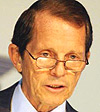The evolution of air travel
Air transport is a mass industry. Every year, more and more people worldwide travel by plane, both domestically and internationally.

Giovanni Bisignani, CEO of IATA.
